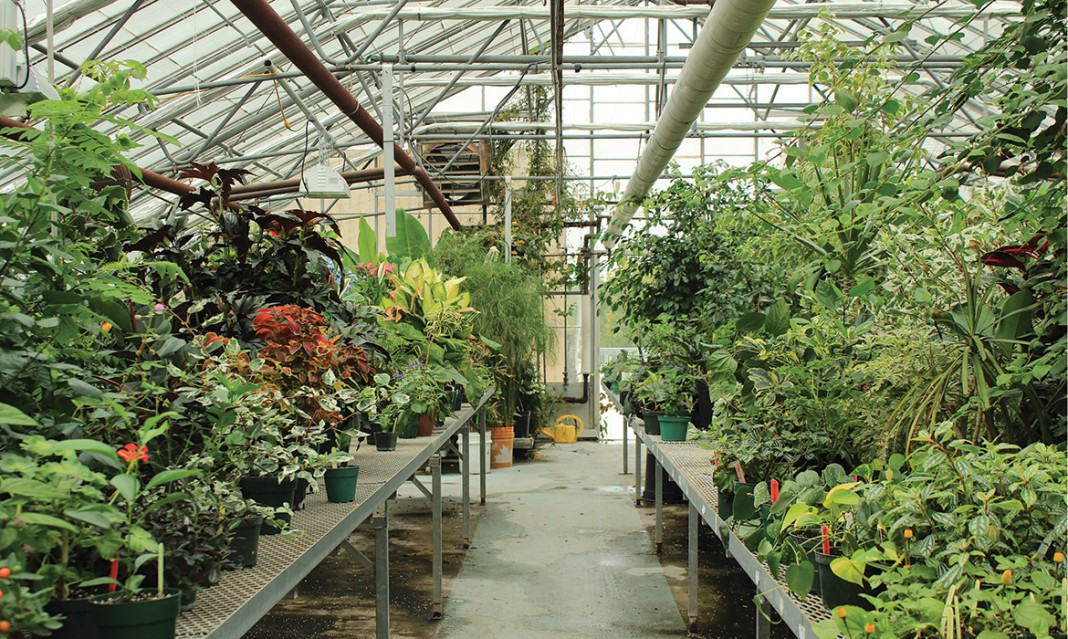The trip to UTM’s greenhouse is somewhat inconvenient and perilous, with winding hallways and only one mysterious elevator that conveys its occupant to the fifth floor of the Davis Building. It seems almost Homeric when you end your long, winding journey with a sanctuary of plants.
The greenhouse stores 300 to 400 species of plants, from various succulents to an array of ficuses. It is a sight to behold: high-pressure sodium lights hang from the ceiling and large bright pink flowers sit in close proximity to sphagnum moss, all coexisting in the narrow space. There are “thousands upon thousands of individual plants, mostly tropical”, according to Marianne Kalich, the greenhouse’s horticulturalist and technician.
Built in 1967, the greenhouse serves as a platform for research and teaching for the biology department, though it is occasionally used by other departments as well. The staff cut plants, propagate new species, and, interestingly, use the plants to support the department’s insect population. As we make our way around to the wetland plants under a large tarp, we pass wheat plants being grown to feed African migratory locusts.
Looking at the large collection of plants suitable for so many different research topics, I ask about some of the most interesting research topics the greenhouse has seen.
Kalich says there are far too many to name, but among her favourite researchers who’ve used the space is one who “worked on all of the species of evening primrose flowers” and grew the plants in the thousands. She also mentioned a faculty member who brought plants from Carleton to work on their medicinal properties, including a strange “toothache plant”, which I had the pleasure of trying. “You bite off the flower head—they look like eyeballs—and you chew them. At first you think nothing, and then boom, it hits you,” says Kalich. “It numbs your whole mouth and you salivate like crazy.” I can personally verify this does indeed occur. It’s oddly enjoyable.
I ask Kalich if there are any she prefers studying. “Succulents—they all have Dr. Seuss-like growth forms; no two are alike,” she says. Kalich first began work at the biology department with plant identification, allowing her to work at UTM’s famous herbarium.
The herbarium, according to Kalich, is not part of the greenhouse but does fall under the jurisdiction of the biology department. It boasts 95,000 different species and is a stark contrast to the brightly lit greenhouse, being a “morgue-like” space “in the depths of the basement” with “big metal cupboards that you crank open” (her words). But the herbarium is an impressive plant library used by researchers around the world. “The specimens usually get lent out to other universities and other plants come in all the time; things come back and forth in our herbarium from the entire globe,” says Kalich.
Though the herbarium is in good shape, partly thanks to retired plant taxonomists who have helped ensure its upkeep, the same cannot be said for the greenhouse.
According to Kalich, plans are underway to open a new greenhouse south of the library, because the existing one has suffered during its long lifetime and many aspects of the structure fail to meet modern day safety codes. It’s also difficult to grow many plants of different climates and conditions in one large open area; the new greenhouse will better address the different needs of various species. Until this one closes down, Kalich says, “As long as something isn’t going on, students can feel free to wander around.”
Kalich finishes our interview by mentioning the annual plant sale from Tuesday to Thursday to raise funds for United Way. Anyone interested in volunteering should email Kalich at marianne.kalich@utoronto.ca with their availability. Volunteers get a free plant of their choosing.




